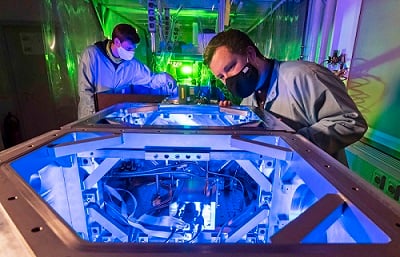JENA, Germany, Nov. 23, 2020 — A team of researchers from the University of Jena has observed the successful formation and interaction of highly ionized krypton plasma, using femtosecond coherent ultraviolet light and a novel four-dimensional model. The research may ultimately deliver insight into the physical formation of the universe.
Plasma is relatively easy to generate in a lab setting, though studying it is nearly impossible; methods capable of capturing ionization states and density are extremely limited. The study of ionized matter is crucial to understanding the relationships at play in forming the universe, as 85% of observable matter consists of dark matter.

Frederik Tuitje (right) and Tobias Helk from the University of Jena in Germany prepare the setup for an investigation of a laser-plasma source. Courtesy of Jens Meyer/University of Jena.
Using a laser-plasma amplifier with eightfold ionized krypton ions as a lasing medium, the researchers launched a coherent extreme ultraviolet (EUV) probe pulse into the plasma. The pulse picked up signatures of the plasma conditions as it propagated the laser-generated plasma column. The pulse was then analyzed by diffracting it off a well-characterized nanoscale target. That method, known as coherent diffraction imaging, allowed measurement of the properties of the probe pulse carrying information about the plasma with high resolution.
Essential to the work is the EUV pulse and, specifically, it being short enough so that the plasma becomes transparent to interrogate the plasma that formed in the setup.
Surprisingly, said Michael Zuerch, professor at the University of California, Berkeley, the researchers found a nontrivial spatial modulation patter unexpected in a waveguide geometry. With an adapted ab initio theory modeling the plasma-light interaction in four dimensions across multiple scales, they found excellent agreement with their experimental data.
“This has allowed us to ascribe the observed signal to a strongly nonlinear behavior in laser-plasma interaction generating the highly ionized krypton plasma,” Zuerch said.
The approach can be easily adopted to other relevant scenarios and validates the advanced ab initio models used to simulate the laser-plasma interaction and more generally the formation of highly ionized plasma. The findings show that arbitrarily ionized plasmas cannot be created through optical techniques.
“The developed model will allow for predicting achievable conditions accurately, and gives hope that very defined plasma conditions can be created by appropriate laser beam shaping,” said Christian Spielmann, professor at the University of Jena.
“Beyond a more profound understanding of laser-plasma interactions, our findings have impacts, for example, on the upscaling of plasma-based x-ray light sources or plasma-based fusion experiments,” Zuerch said.
The research was published in Light: Science & Applications (www.doi.org/10.1038/s41377-020-00424-2).